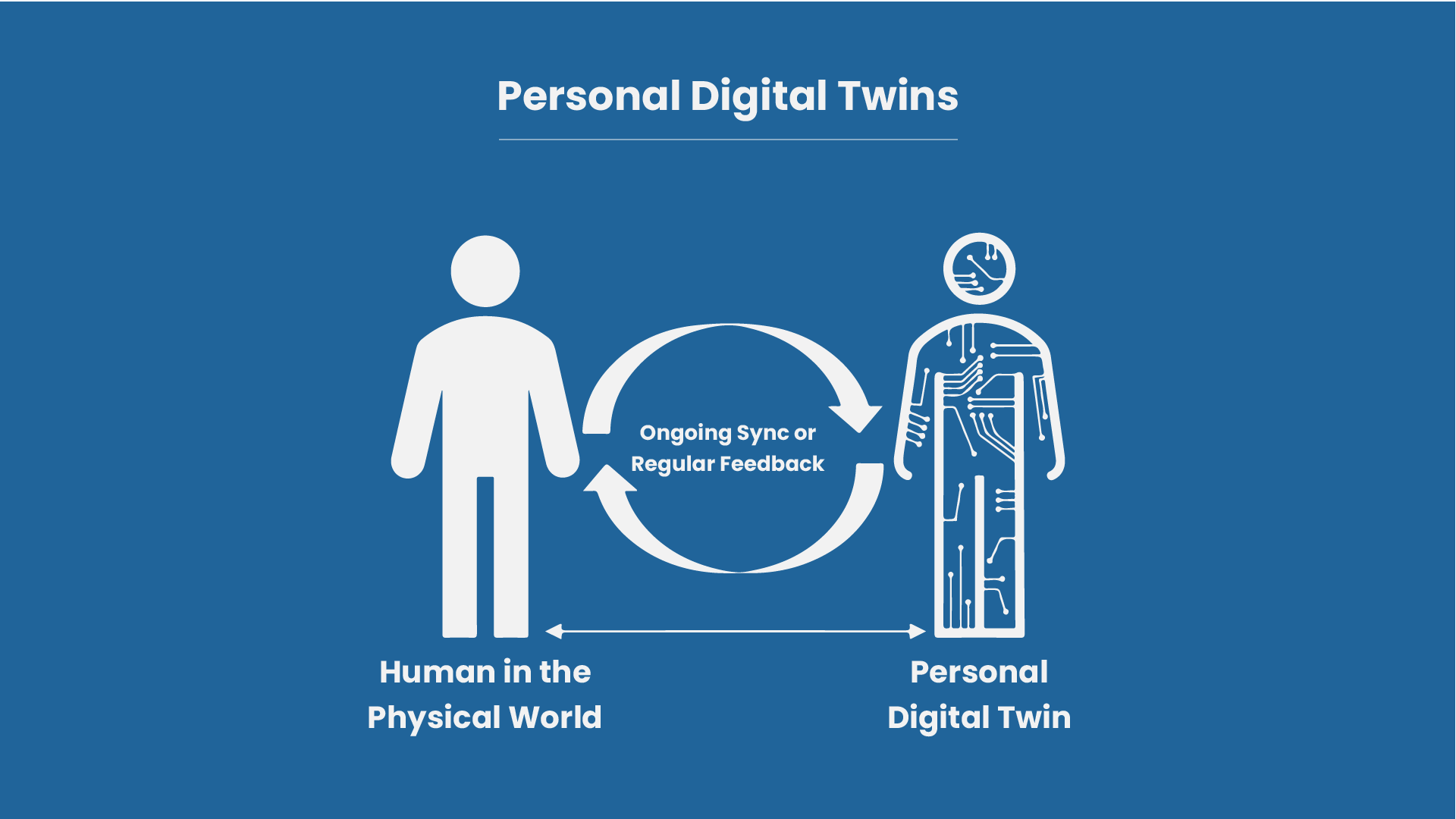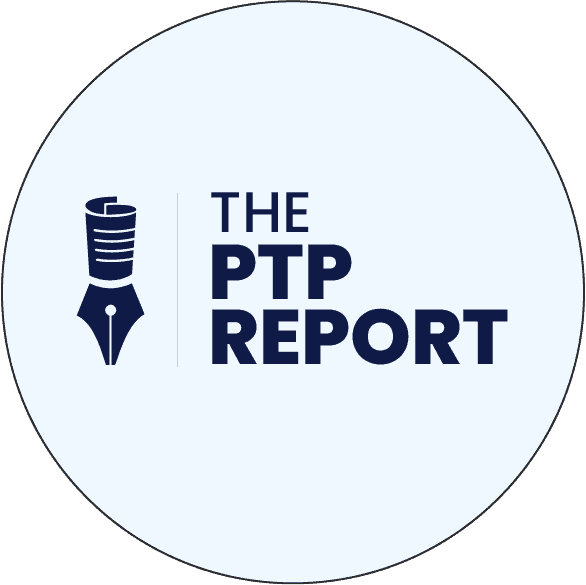Digital twins are everywhere right now, from infrastructure to healthcare to agriculture to education. According to a recently completed NIST survey, they’re worth tens of billions of dollars in manufacturing alone.
With roots in the NASA space program, digital twins are virtual replicas of real things reinforced by a continuous, ideally bi-directional flow of data between the real and the simulation. And bolstered by recent technological innovations, they’re now being made of almost everything, no longer limited to projects of enormous scale or expense.
Driven by the wide availability of data and the surge in AI capacity, it’s now possible to even make a digital twin of yourself.
A recent New York Times piece by Eli Tan takes one form on a test run, looking at “AI clones” that date other clones to see if they’re a match. (There are also AI dating coaches to give feedback.)
Okay, great, but what other benefits could such personal digital twins have?
In today’s PTP Report we take a look, focusing on the applications and challenges of creating your own digital doppelganger.
What Is a Personal Digital Twin?
The idea of cloning yourself as a personal or human digital twin is the same as any other digital twin: First, a digital copy (audio/visual) virtual avatar is created. For simpler versions, it can be something that just mimics your behavior based on provided scripts. For the more complex, a map of internal biological systems.
Next an AI model is added to the mix, trained with data representative of your knowledge and/or physiology. For capturing your mindset, this can be samples of writing, recordings of video and audio, emails and text correspondence, and more.
For digital twin applications in healthcare or sports, extensive medical knowledge is used, from blood tests to internal scans, using data from past examinations or performances.
Combined, you have the same thing NASA once constructed at great expense for high-risk spacecraft: a virtual version of you that reflects the real thing.
With your likeness, voice, and even knowledge, this copy can carry out conversations, take tests, or share information independently.
It may sound like science fiction, but it’s increasingly becoming reality, as in this example by Northwestern Kellogg School McCormick Foundation Professor Mohanbir Sawhney.

How they work:
- Data Collection: What differentiates a personal or human digital twin from a virtual avatar is as much data as possible. Wearable devices, from smartwatches or fitness trackers to extra sensors (even implantable for medical need), collect metrics like heart rate, blood pressure, activity level, or even sleep patterns. And increasingly smartphones add behavioral data into the mix.
- Data Modeling: AI and machine learning algorithms work with data sources, enabling simulation, as well as prediction and insight. The better and more consistently updated the data, the better the model can be trained and refined, as in all digital twin applications. For experts who’ve written and recorded lectures at scale, the potential comes to generate new material from models.
- Feedback and Synchronization: The more bi-directional the data flow, the better. Digital twins across applications harness real-time data where possible. And while personal or human digital twins can’t as easily include updates beyond biological metrics, using wearables with sensors or having active user feedback (such as through training or UI), improves the fidelity.
In the end, the goal is a digital mirror, a version that doesn’t capture who you have been to date, but projects you could be across a variety of situations.
Emerging Uses
As of now, most personal or human digital twin use cases are in the testing or experimental phase. Aside from entertainment, it’s easy to see their application in providing wider access to subject matter experts, be it teachers, doctors, lawyers, salespeople, or leaders, allowing direct one-on-one engagement most anywhere, or anytime.
Working as your promotional copy, such a one-to-many model could enable you to share your knowledge on demand, leaving you free to tend to other demands from running your business, teaching class, performing surgeries, or developing new products and solutions.
For Healthcare
Experimental digital twins of individuals are already in use for cancer treatment, predicting treatment responses to different chemotherapy drug classes. Using digital twins of patients, these predictions can be made in minutes, making it feasible even on-site, at clinics, and in hospitals.
Consultant oncologist and co-founder and chief scientific officer at Concr Dr. Uzma Asghar tells Inside Precision Medicine:
“The great thing about using this technology is that the more information you feed into the digital twin about that individual, the better the predictions become, but it also allows you to follow the patient’s cancer journey.”
These are in use both in individual and consolidated cases, to help specify data-driven treatment options, practice medical procedures, and sharpen diagnoses.
They can also improve monitoring, provide greater insight, even predictively, on an individual’s health and wellbeing. Researchers are using digital twins to track blood glucose levels, for example, to stay ahead of changes in real-time.
Such advancements are expected to decrease hospital admissions and improve the access, and immediacy, of care.
The time is not so far away when a personal digital twin may predict a stroke or heart attack before it happens, enabling life-saving intervention at far lower cost.
Education
As discussed above, one immediate application is for educators, who can share their knowledge more directly with students. Imagine being able to query your professor at any time of the day or night, having a personalized interaction about your specific questions.
Meta is testing digital twin advancements now at 13 institutions, in subjects like science, medicine, history, and languages. Unsurprisingly, their “metaversity” program will feature VR and mixed reality testing.
The goal across the board is to span the gap between the physical and the digital, be it in larger, situational cases, or using replicas of individuals.
With a capacity to try hands-on skills work in safe environments with direct, real-time feedback, digital twin technology can boost warehouse safety and speed the development of expertise for aircraft pilots. And all with the capacity to personalize the learning experience.
Workplace Efficiency
One of our prior articles focused on using digital twins in cybersecurity, with models geared toward replicating technological structures, such as a network architecture.
In hiring, personal/human digital twins are already being tested on both sides of the process. Digital twins of recruiters can conduct initial screenings with potential candidates, answer simple questions, do scheduling, and administer tests.
Work is also going into digital twins of candidates, modeled to serve as a kind of 3D smart resume, capable of answering resume questions and sharing simple information. While these aren’t available yet, they are part of the future of digital twin technology where doppelgangers will share generalized knowledge, much as in the dating example, without wasting a person’s time until greater depth is needed.
Merging across these applications, we see applications for the digital twin in workplace training tests, in modeling consumers, and for greater access to subject matter experts.
[Also check out this Substack from our CEO on the future of training with VR and conversational AI.]
Smarter Decision-Making
Imagine being able to scan the equivalent of a QR code and interact immediately with a personal digital twin who is an expert on a given product.
Standing there in the store (or at home), you could ask specific questions to determine fit or troubleshoot problems. This could be the designer, inventor, or even the farmer who grew a particular type of produce.
More broadly, such a digital twin of yourself can give you far greater insight into yourself. Having trouble sleeping? Your twin could help diagnose the cause and offer potential solutions. Want to be more efficient? Lose weight? Learn a new skill? Your digital clone could help, sharing insights from the psychological to the organizational to the physical.
While we already see these innovations in use for professional athletes, it’s increasingly practical for all of us, whether it’s to improve your golf swing, understand repetitive injuries from weights or running, or identify the best type of exercise or dietary changes to improve your mood.
Remaining Challenges
While many of those innovations are already in the experimental stages, a detailed research paper by scholars in Denmark and the UK considers the topic broadly, including the challenges of digital twins still being resolved.

Human beings are complicated and unpredictable. And compared to other forms of digital twins (automobiles, workplaces, warehouse floors, machinery, network systems), we are also highly variable.
In the examples above, we covered approaches to modeling—these abstract people in numerous ways, from our circulatory system to our verbal output.
The necessary data must be measured, communicated, and modeled in a variety of ways, too, based on need, budget, and availability. Without clear standards and better interoperability, having consistency here will be incredibly difficult, making it hard to move such projects beyond the experimental.
The greatest challenge, as usual, is to get sufficient, quality data. Digital twins for any application are only as good as the data being used (and updated). In experimental cases, this is often unorganized and not gathered or stored with a focus to this use case. This means added time and difficulty in collection, cleaning, and organization, as well as limits for comparison.
Personal digital twins can also pose risks to their sources. With behavioral tracking, personal history, health metrics, and more in play, they become an appealing target for cybercriminals.
There are also significant ethical and digital twin data privacy considerations, and without greater standardization, these are hard to govern, observe, and verify successfully.
Considering that such models can increasingly emulate our decision making, we need to be sure they cannot be used against us.
In terms of digital twin security, even aside from leaking personal data or cases of fraud, there’s a risk of direct harm, as in healthcare or in uses of the digital twin for education. Without verifiable accuracy, they cannot be trusted in areas of importance.
And who owns your digital twin? If a subject matter expert, for example, shares all their updated knowledge with a virtual clone, who gets paid for the work it does, be it teaching classes, doing recruitment work, or serving as a corporate knowledge base?
Conclusion
As wild as some of these cases seem, many are already on their feet in experimental use. With ongoing advancements in AI improving their agency and accuracy, it’s only logical that more of us, too, will be modeling systems on our own personal knowledge and likeness.
And with advances in augmented or virtual reality, the line between the real and digital is only further blurred.
Given how much we still need to learn about human consciousness, there’s no real danger in the near term from digital doppelgangers replacing us.
But what they can already do is extend our reach, allowing a greater distribution of knowledge and capacities, giving doctors greater insight and room to experiment, and allowing us more insight on how we work and why.
The speed of this advancement is scary: there are risks for success, privacy, and safety which aren’t trivial, but the potential rewards are also great. Already we see digital fakes of the recently-deceased being used to comfort survivors.
It’s not a great leap from there to imagine our digital twins outliving us, and with practically applicable uses.
References
Are A.I. Clones the Future of Dating? I Tried Them for Myself, The New York Times
Economics of Digital Twins: Costs, Benefits, and Economic Decision Making, NIST Advanced Manufacturing Series; NIST AMS 100-61
Getting The Biggest ROI On Your Digital Twin, Semiconductor Engineering
Digital Twin Model Predicts Chemotherapy Responses in People with Cancer, Inside Precision Medicine
Meta taps US, UK universities to test VR in education, creates digital twin ‘metaversities’ in Europe, TechCrunch
Towards the Human Digital Twin: Definition and Design — A survey, arXiv:2402.07922





